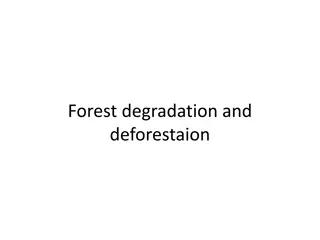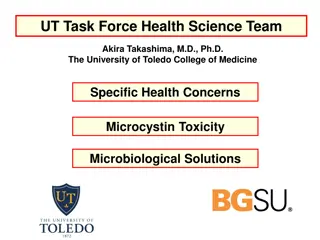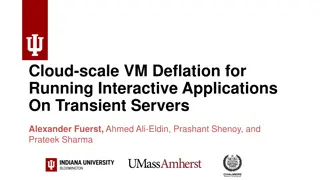Understanding Optical Fiber Signal Degradation in Communication Engineering
Technocrats Institute of Technology (Excellence) in Bhopal delves into the concepts of signal degradation in optical fiber communication, focusing on attenuation, distortion mechanisms, and measurement techniques. The institute emphasizes the importance of signal attenuation and its impact on inform
4 views • 56 slides
WHONET Training Course: Laboratory Configuration and Setup
Understanding the laboratory configuration process in WHONET is crucial for effective data entry and analysis. This module guides users on setting up a new laboratory, entering country and lab details, defining antibiotics, sample locations, and data fields, creating microbiological alerts, and savi
3 views • 57 slides
Food spoilage
In this lecture from the Department of Pathological Analyses at the University of Basrah, Prof. Dr. Saad S. Mahdi Al-amaradi Al-Amara discusses food spoilage, focusing on cereals, bakery foods, and meat products. The presentation covers the microbial spoilage of grains, including common mold species
0 views • 9 slides
Ensuring Biosafety in Laboratory Settings: Barriers and Practices
Biosafety in laboratories involves implementing various barriers and practices to prevent the release of biological agents and protect lab workers. These include primary and secondary barriers, personal protective equipment (PPE), containment principles, and adherence to biosafety practices. Safety
1 views • 41 slides
FDA Perspective on Epidemiological Cut-off Values (ECVs)
The FDA presents insights on the development and use of Epidemiological Cut-off Values (ECVs) to distinguish wild-type populations from those with acquired resistance mechanisms. ECVs are crucial for determining antimicrobial susceptibility and guiding treatment decisions. The process involves analy
0 views • 13 slides
Understanding Pharmaceutical Degradation: Types and Factors
Pharmaceutical degradation refers to the process of a formulation in a specific container losing its chemical, microbiological, therapeutic, physical, and toxicological specifications. It can be categorized into physical, chemical, and microbiological degradation. Physical degradation alters the dru
1 views • 50 slides
Nutrient Requirements of Industrial Media
Microbiological media for industrial and laboratory purposes need to provide essential nutrients like carbon, nitrogen, minerals, growth factors, and water while avoiding growth-inhibitory substances. Carbon, nitrogen, minerals, and growth factors play key roles in supporting microbial growth, and t
0 views • 25 slides
Solutions to Combat Land Degradation in the Sahel Region
Addressing land degradation in the Sahel through solutions like diguettes, managing grazing areas, and farmer education can help increase crop yields, prevent soil erosion, and promote sustainable land management. While these solutions have proven effective in various regions, challenges such as ini
1 views • 23 slides
Understanding Normal Flora of the Gastrointestinal Tract & Infectious Diarrhea
Normal flora in the gastrointestinal tract play a crucial role in maintaining health, but can also cause disease in certain conditions. This lecture covers the common flora in the GIT, their role in diseases, various types of acute diarrheal illnesses, epidemiology, and management of bacterial agent
1 views • 26 slides
Sources of Drugs and Their Origins
Drugs can be sourced from six major categories: plants, animals, minerals/earth, microbiological sources, semi-synthetic sources, synthetic sources, and recombinant DNA technology. Plant sources, being the oldest, provide various medicinal properties through leaves, flowers, fruits, seeds, roots, ba
0 views • 11 slides
Significance of Raw Materials in Food Processing
Effective selection of raw materials is crucial for ensuring the quality of processed food products. The quality of raw materials directly impacts the final products, making it important to procure materials that align closely with processing requirements. Quality evaluation, including microbiologic
2 views • 30 slides
Understanding Water Activity and Mass Transfer in Food Engineering
Water activity (aw) plays a crucial role in microbial activity, chemical and physical changes in foods, and the dehydration process. Maintaining water activity below specific levels can prevent microbiological spoilage and deterioration reactions, while also affecting texture, aroma, and overall qua
0 views • 11 slides
Understanding Penck's Cycle of Erosion in Geomorphology
Walther Penck introduced an alternative model to Davisian cycle, emphasizing the interplay between upliftment and erosion rates in landscape formation. Penck's concept focuses on relative intensity of degradation processes, phase of upliftment, and rates of erosion, rejecting the idea of stages in l
2 views • 32 slides
Overview of Market Milk: Types, Standards, and Microbiological Quality
Market milk encompasses various types such as standardized, full cream, and skimmed milk, each with specific standards and microbiological requirements. Factors affecting microbiological quality include raw milk quality and processing steps. Understanding these aspects is crucial for maintaining the
0 views • 22 slides
Understanding Polymer Degradation Processes in Chemistry
Polymer degradation involves a reduction in molecular weight due to various factors like heating, mechanical stresses, radiation, oxygen, and moisture. Two main types of degradation include chain end degradation and random degradation, each affecting the polymer structure differently. Chain end degr
0 views • 12 slides
Chronic Otitis Media: Classification, Causes, and Management
Chronic otitis media is a persistent inflammation of the middle ear mucosa and mastoid process for more than 3 months. It can be classified as tubotympanic or attico-antral, with the new classification including inactive and active mucosal and squamous types. The condition is influenced by factors l
0 views • 36 slides
Optimizing Antibiotic Use in Treating Infections
Antibiotics are vital for treating and preventing infections, but research shows they are often prescribed unnecessarily or misused. Evidence-based guidelines from IDSA can assist in choosing the right therapy based on accurate infectious disease diagnosis and microbiological understanding. Proper s
1 views • 51 slides
Understanding Coagulase Test in Microbiology
The Coagulase test is a crucial microbiological method used to differentiate Staphylococcus aureus (Coagulase Positive) from other Staphylococci (Coagulase Negative). By detecting the presence of the enzyme coagulase, this test helps identify pathogenic strains of Staphylococcus that can cause serio
2 views • 28 slides
Understanding Microbiology Testing Methods and Results
Explore the various methods of microbiology testing, learn to interpret microbiological test results, and understand antibiotic susceptibility testing. Discover details on bacterial, viral, and parasitic infections through laboratory reports and supporting results like WBC counts and pathogen identi
0 views • 29 slides
Microbiological Quality Control in Pharmaceutical Environment
Microbiological products in pharmaceutical settings are influenced by the quality of materials and the environment. Good Manufacturing Practices (GMP) are essential to minimize contamination risks, with control points focused on the ecology of microorganisms. Sources of contamination include the atm
1 views • 128 slides
Managing Microbiological Quality in Pharmaceutical Environments
The quality of microbiological products is influenced by the pharmaceutical environment materials. Good Manufacturing Practices (GMP) play a crucial role in minimizing contamination risks. Various sources of contamination include the atmosphere, water, persons, raw materials, packaging, buildings, a
0 views • 128 slides
Enhancing Land Degradation Neutrality Targets in Lebanon's National Action Programme
Integrating LDN targets into Lebanon's National Action Programme, led by Dr. Chadi Mohanna, aims to align the NAP with the UNCCD's 10-Year Strategy, set national targets for Land Degradation Neutrality, and implement measures to combat land degradation aggravated by climate change. The project focus
0 views • 23 slides
Microbiological Inspection of Mineral Water by Redox Potential Measurement
MicroTester is a validated method for rapid microbiological testing of various types of water such as mineral water and carbonated water. Real-time monitoring of microbial properties in water production is crucial for ensuring safety and quality. The energy for microbial growth comes from biological
0 views • 27 slides
Understanding Deforestation and Forest Degradation: Causes and Impacts
Deforestation and forest degradation are significant environmental issues driven primarily by agriculture, logging, and population growth. Other causes include corruption, inequitable distribution of wealth and power, and urbanization. Globalization and historical exploitation also play a role. Deve
0 views • 53 slides
Urgency of Watershed Management for Sustainable Agriculture
Watershed management is crucial due to dwindling land availability, water scarcity projections, and the severe threat of soil erosion and land degradation. With vast regions affected by these issues, especially in rainfed areas, there is a pressing need to address resource degradation to ensure food
0 views • 50 slides
Simulation Assumptions and Performance Degradation Study on Beam Squint in 3GPP Meeting
Background on beam squint in conducted power of transmitted CCs causing radiative domain impairment and gain droop, with a problem statement on degradation of CC2 spherical coverage when CC1 and CC2 are separated by frequency. The study involves refined simulation assumptions to quantify radiative d
0 views • 7 slides
Comprehensive Approach to Address Microcystin Toxicity and Solutions by UT Health Science Team
The UT Task Force Health Science Team, led by experts in various fields, focuses on addressing specific health concerns related to Microcystin toxicity. They employ a multidisciplinary approach, utilizing expertise in clinical medicine, public health, microbiology, and molecular biology. The team pr
0 views • 7 slides
Understanding REDD+ and Forest Governance for Sustainable Resource Management
REDD+ stands for Reducing Emissions from Deforestation and forest Degradation, encompassing activities to enhance carbon stocks, conservation, and sustainable forest management. Forest governance plays a crucial role in reducing risks related to land use change, illegal logging, and forest degradati
0 views • 11 slides
Understanding Purine Degradation and Gout
Purine degradation pathway involves the breakdown of dietary nucleic acids, mainly from meat, into uric acid through specific enzymatic steps. Excessive uric acid production can lead to conditions like gout and hyperuricemia. Humans excrete uric acid in the urine as the final product, while other an
1 views • 12 slides
Addressing Land Degradation Challenges in Agriculture for Sustainable Development
World agriculture has evolved over the decades, facing challenges like environmental degradation and land misuse. Awareness-raising activities on biosafety and biodiversity are crucial for informed decision-making in agriculture. Nigeria, with its diverse ecological zones, must sustainably manage na
0 views • 13 slides
Achievements and Strategies in Land Degradation Management
The Global Environment Facility (GEF) has made significant investments in sustainable land management, particularly in drylands, to combat land degradation through projects in over 40 countries. The objectives include maintaining agro-ecosystem services, generating sustainable forest ecosystem servi
0 views • 10 slides
5 Steps Questionnaire on Mapping Land Degradation and Sustainable Land Management
Preparation for mapping land degradation and sustainable land management involves steps such as preparing the base map, identifying contributing specialists, assessing land use systems, understanding land degradation types, and providing expert recommendations. The process includes analyzing area tr
0 views • 32 slides
Land Degradation Offset and Mitigation in Western Mongolia Project Overview
This project in Western Mongolia aims to address land degradation issues caused by mining activities by implementing offsetting principles, supporting pasture restoration, and enhancing biodiversity conservation. With a total funding of 6,569,863$, the project targets to conserve ecosystem integrity
0 views • 19 slides
Regulation Proposal to Combat Deforestation and Forest Degradation in the European Union
The European Commission is proposing a regulation to prevent the entry and export of commodities linked to deforestation and forest degradation. This aligns with political commitments such as the European Green Deal and the Farm to Fork Strategy. Existing legislation like the FLEGT Regulation and th
0 views • 32 slides
Insights into Soil Stiffness Degradation Using Seismic Dilatometer Data
This content discusses the analysis of soil stiffness degradation curves using data collected from the Flat Dilatometer and Seismic Dilatometer tests. Researchers Sara Amoroso and Paola Monaco present methods for deriving in situ G- decay curves and evaluating shear strain data in various soil types
0 views • 18 slides
Industrial, Microbiological & Biochemical Analysis - Course Overview by Dr. Anant B. Kanagare
Dr. Anant B. Kanagare, an Assistant Professor at Deogiri College, Aurangabad, presents a comprehensive course on Industrial, Microbiological, and Biochemical Analysis (Course Code ACH502). The course covers topics such as Industrial Analysis, Microbiological Analysis, and Biochemical Analysis. Dr. K
0 views • 16 slides
Best Practices for Specimen Collection in Microbiological Examinations
Proper specimen collection is crucial for accurate microbiological examination results. Starting investigations early, avoiding contamination, and using leak-proof sterile containers are key. Important questions and considerations before collecting a specimen, along with criteria for rejecting sampl
0 views • 28 slides
Cloud-Scale VM Deflation for Running Interactive Applications on Transient Servers
This research explores the concept of deflatable virtual machines to run interactive applications on transient cloud servers without facing unexpected preemption. By reclaiming resources from low-priority VMs and allowing forward progress with some performance degradation, the method aims to provide
0 views • 29 slides
Performance Degradation Summary for FRIB Cryomodule VT vs. Bunker
FRIB's performance degradation analysis focuses on validating the design of the cryomodule, with tests conducted under various operational conditions to assess parameters such as cryogenic losses, SRF subsystems performance, and cavity dynamics. The ReA6-1 cavity's performance, measured in terms of
0 views • 5 slides
ppt (1)Leading Experts in Microbiological Testing Services at Amplikon Biosystem
Amplikon Biosystems offers top-notch microbiological testing services to ensure product safety and quality across industries like pharmaceuticals, food, and healthcare. With advanced technology and experienced microbiologists, we provide accurate and
3 views • 3 slides







































